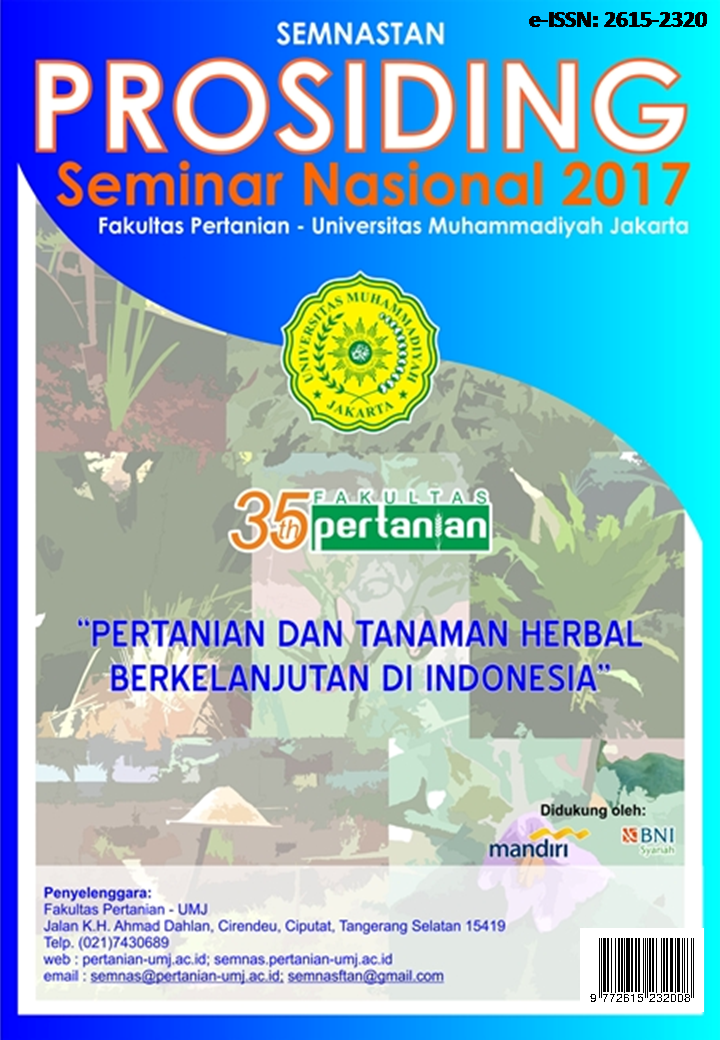PENGARUH BENZILAMINOPURIN DENGAN PENAMBAHAN KNO3 PADA MULTIPLIKASI TUNAS Colocasia esculenta (L.) Schott VAR. Antiquorum
Abstract
Talas satoimo merupakan makanan sumber karbohidrat, kebutuhannya melebihi kapasitas produksi sehingga memiliki peluang besar di pasaran. Perbanyakan tunas memberikan alternatif untuk memenuhi tuntutan pasar. Melalui penggunaan benzilaminopurin dan kombinasi KNO3 diharapkan dapat mengetahui media optimal bagi perbanyakan tunas talas satoimo. Penelitian ini dilaksanakan di Balai Bioteknologi, BPPT, Setu, Tangerang Selatan dengan metode penelitian menggunakan Rancangan Acak Lengkap (RAL) faktorial yg terdiri dari 2 faktor, yaitu faktor pertama konsentrasi KNO3 0, 300, 600 dan 1200 ppm dan faktor kedua konsentrasi BAP 0; 0.2; dan 0.6 ppm. Media dasar menggunakan Murashige-Skoog (MS). Pengamatan dilakukan setiap minggu selama 6 minggu setelah tanam (MST). Hasil pengamatan menunjukkan bahwa perlakuan BAP 0.6 ppm dengan penambahan KNO3 300 ppm optimal bagi perbanyakan tunas.ABSTRACTTalas satoimo is a carbohydrate source, the production capacity less than necessary so it has potential market. Shoot multiplication provide alternative to supply demand market. Through use of Benzylaminopurine and combination KNO3 will discover optimal medium for shoot multiplication. This study conducted at Research Center for Biotechnology, BPPT, Setu, Tangerang Selatan. The method using complete random factorial design consisted of two factor that is concentration combination KNO3 at 0, 300, 600 and 1200 ppm and Benzylaminopurine at 0, 0.2, 0.6 ppm. The basic media using Murashige-Skoog (MS). Observation were set every weeks during six weeks after planting. The optimal growth was obtained at MS medium containing Benzylaminopurine 0.6 ppm in combination with KNO3 300 ppm.References
Awasthi, C.P. dan A.B. Singh. 2000. Nutrional Quality Evaluation of Edible Leaves of Some Promising Colocasia and Alocasia Collections. Indian Journal of Agricultural Research, Vol. 34 (2): 117 – 121.
Chand, H., M.N. Pearson, dan P.H. Lovell. 1999. Rapid vegetative multiplication in Colocasia esculenta (L.) Schott (taro). Plant Cell Tissue and Organ Culture: 223 – 226.
Chng, R.C.O. dan C. Goh. 1994. High Frequency Direct Shoot Regeneration from Corm Axillary Buds and Rapid Clonal Propagation of Taro, Colocasia esculenta (L.) Schott var. esculenta (Araceae). Plant Science, Vol. 104 (1): 93 – 100.
Cho, J.J., R.A. Yamakawa, dan J. Hollyer. 2007. Hawaiian Kalo, Past and Future (1st ed.). Honolulu, Hawaii: Cooperative Extension Service, College of Tropical Agriculture and Human Resources. University of Hawaii. Manoa.
Du, H.M., D.M. Tang, dan D.F. Huang. 2006. ‘Fragrant taro’ [Colocasia esculenta (L.) Schott var.antiquorum] Micropropagation Using Thidiazuron and Benzylaminopurine. The Journal of Horticultural Science and Biotechnology, Vol. 81 (3): 379 – 384.
Eliantosi dan Darius. 2015 . Karakteristik Fisik, Kimia, Dan Organoleptik Mie Mosaf (Modified Satoimo Flour) (Colocasia esculenta). Agritepa, Vol. 1 (2): 188 – 194.
Gamborg, O.L., dan J.P. Shyluk. 1970. The Culture of Plant Cells with Ammonium Salts as the Sole Nitrogen Source. Plant physiology. Vol. 45: 598 – 600.
George, E.F. dan P.D. Sherrington 1984. Plant Propagation By Tissue Culture (1st Ed.). Edington: Exegetics Limited. Basingstoke, UK.
George, E.F. 2008. Plant Propagation by Tissue Culture 3rd Edition. Springer: 65 – 113.
Kurniati, M. 2014. Pengaruh Konsentrasi Colchicine terhadap Pertumbuhan Dendrobium spectabile dalam Kultur In Vitro. Skripsi. Departemen Konservasi Sumberdaya Hutan dan Ekowisata, Fakultas Kehutanan. Institut Pertanian Bogor.
Marreta, D., D.P. Handayani, H. Rosadayanti, dan A. Tanjung. 2016. Multiplikasi dan Induksi Umbi Mikro Satoimo (Colocasia esculenta (L.) Schott) pada Beberapa Konsentrasi Sukrosa dan Benzilaminopurin. Jurnal Bioteknologi Biosains, Vol. 3 (2): 81 – 88.
Seameo. 2007. Talas Jepang (Satoimo). Biotrop Services Laboratory. http://sl.biotrop.org/index.php (diakses pada 21 Maret 2017)
Sen, A. dan A. Batra. 2011. Crucial Role of Nitrogen In In Vitro Regeneration of Phyllanthus amarus Schum and Thonn. International Journal of Pharmaceutical Science and Research, Vol. 2 (8): 2146 – 2151.
Shanjani, P.S. 2003. Nitrogen effect on callus induction and plant regeneration of Juniperus excelsa. International Journal of Agriculture and Biology, Vol. 5 (4): 419 – 422.
Shirin, F., N.S. Parihar dan S.N. Shah. 2015. Effect of nutrient media and KNO3 on in vitro plant regeneration in Saraca acosa (Roxb.) Willd. American Journal of Plant Science, 6: 3282-3292.
Verma, V.M. dan J.J. Cho. 2010. Plantlet development through somatic embryogenesis and organogenesis in plant cell cultures of Colocasia esculenta (L.) Schott. AsPac J. Mol. Biol. Biotechnology, Vol. 18 (1): 167 – 170.
Woodward, A.J., I.J. Bennett dan S. Pusswonge. 2006. The effect of nitrogen source and concentration, medium pH and buffering on in vitro shoot growth and rooting in Eucalyptus marginata. Scientia Horticulturae, Vol. 110 (2): 208 – 213.

